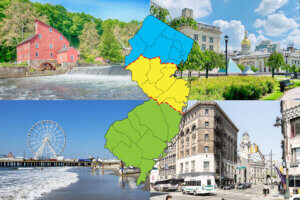In its regular tracking of residents’ satisfaction with life in New Jersey, the Monmouth University Poll finds the current Garden State Quality of Life Index stands at +21. This is down significantly from other post-Superstorm Sandy readings, including +29 in February and +30 in December. In fact, the current score matches the prior low from December 2010, when Monmouth first introduced the index.
A major factor in the index score is residents’ overall rating of the state as a place to live. Currently, more than 6-in-10 say New Jersey is either an excellent (15%) or good (46%) place to call home, compared to nearly 4-in-10 who rate it as only fair (27%) or poor (11%). This 61% positive rating is down by 7 points from the February poll and by 11 points from a decade-high 72% recorded in December just after Superstorm Sandy hit the state.
The decline in state ratings is accompanied by a drop in local evaluations. Specifically, 67% of New Jerseyans currently rate their town or city positively, down from 73% in February. This marks the lowest result for hometown evaluations in more than 30 years. The last time fewer than 7-in-10 New Jersey residents viewed their hometown positively was in 1980, when the number was also 67%.
Another area that shows a downturn in residents’ perceptions is the local school rating. Currently, 59% of New Jerseyans give their local schools a thumbs up, down 5 points since February. On the other hand, ratings of local environmental quality stayed stable at 70% positive and views of neighborhood safety actually went up by 3 points to 66% positive.
“The feelings of goodwill that permeated the state after Sandy have disappeared, even wiping out positive gains made prior to the storm. New Jerseyans are once again looking at the state’s quality of life with a more critical eye,” said Patrick Murray, director of the Monmouth University Polling Institute.
The Garden State Quality of Life Index score declined for nearly every demographic group when compared to February’s results, with the exception of those earning over $100,000 a year for whom it remained fairly steady at +35. Regionally, the index score registered double digit drops in Urban Core counties (+4), the Route 1 Corridor (+19), and the Northern Shore (+22). The index stayed relatively more stable in areas not as affected by Sandy, including the Central Hills (+38), the Northeast (+31), the Garden Core counties (+21), and the Delaware Valley (+21). In fact, the Delaware Valley region, which suffered the least impact from Sandy, registered the most stable Quality of Life ratings for the period six months before Sandy hit to six months after, ranging narrowly from +21 to +26 during that time.
The Garden State Quality of Life Index was created by the Monmouth University Polling Institute to serve as a resident-based indicator of the quality of life offered by the state of New Jersey. The index is based on five separate poll questions: overall opinion of the state as a place to live – which contributes half the index score – and ratings of one’s hometown, the performance of local schools, the quality of the local environment, and feelings of safety in one’s own neighborhood. The index can potentially range from -100 to +100.
The latest Monmouth University Poll was conducted by telephone with 806 New Jersey adults from April 11 to April 14, 2013. This sample has a margin of error of +/- 3.5 percent. The poll was conducted by the Monmouth University Polling Institute in West Long Branch, New Jersey.
DATA TABLES
The questions referred to in this release are as follows:
(* Some rows may not add to 100% due to rounding.)
1. Overall, how would you rate New Jersey as a place to live – excellent, good, only fair, or poor?
| TREND: |
Excellent/ | Excellent | Good | Only Fair | Poor | (VOL) Don’t know |
(n) |
| April 2013 | 61% | 15% | 46% | 27% | 11% | 0% | (806) |
| February 2013 | 68% | 18% | 50% | 24% | 7% | 1% | (803) |
| December 2012 | 72% | 20% | 52% | 21% | 5% | 1% | (816) |
| September 2012 | 65% | 15% | 50% | 23% | 11% | 0% | (805) |
| July 2012 | 69% | 17% | 52% | 23% | 8% | 0% | (803) |
| April 2012 | 70% | 20% | 50% | 23% | 7% | 0% | (804) |
| February 2012 | 62% | 15% | 47% | 26% | 11% | 1% | (803) |
| October 2011 | 67% | 15% | 52% | 24% | 8% | 0% | (817) |
| August 2011 | 57% | 14% | 43% | 31% | 11% | 1% | (802) |
| May 2011 | 59% | 14% | 45% | 29% | 11% | 0% | (807) |
| December 2010 | 63% | 17% | 46% | 26% | 10% | 1% | (2864) |
| October 2007 | 63% | 17% | 46% | 25% | 12% | 1% | (1001) |
| August 2004 | 68% | 22% | 46% | 21% | 10% | 1% | (800) |
| May 2003 | 72% | 20% | 52% | 23% | 5% | 0% | (1002) |
| April 2001 | 76% | 23% | 53% | 19% | 4% | 1% | (802) |
| March 2000 | 76% | 25% | 51% | 17% | 6% | 0% | (800) |
| May 1999 | 76% | 22% | 54% | 19% | 5% | 0% | (800) |
| February 1994 | 71% | 18% | 53% | 22% | 7% | 0% | (801) |
| March 1990 | 68% | 21% | 47% | 25% | 6% | 1% | (800) |
| February 1988 | 78% | 27% | 51% | 17% | 4% | 1% | (800) |
| February 1987 | 84% | 31% | 53% | 11% | 4% | 0% | (800) |
| May 1985 | 81% | 29% | 52% | 14% | 3% | 1% | (500) |
| October 1984 | 80% | 29% | 51% | 15% | 4% | 1% | (1000) |
| January 1981 | 66% | 16% | 50% | 26% | 7% | 1% | (1003) |
| July 1980 | 68% | 18% | 50% | 23% | 7% | 2% | (1005) |
2. How would you rate your town or city as a place to live – excellent, good, only fair, or poor?
| TREND: |
Excellent/ | Excellent | Good | Only Fair | Poor | (VOL) Don’t know |
(n) |
| April 2013 | 67% | 29% | 38% | 25% | 8% | 0% | (806) |
| February 2013 | 73% | 30% | 43% | 20% | 7% | 0% | (803) |
| December 2012 | 74% | 32% | 42% | 17% | 9% | 0% | (816) |
| September 2012 | 72% | 33% | 39% | 19% | 9% | 0% | (805) |
| July 2012 | 74% | 32% | 42% | 18% | 7% | 1% | (803) |
| April 2012 | 76% | 34% | 42% | 17% | 7% | 0% | (804) |
| February 2012 | 74% | 33% | 41% | 21% | 5% | 0% | (803) |
| October 2011 | 73% | 26% | 47% | 20% | 8% | 0% | (817) |
| August 2011 | 76% | 28% | 48% | 18% | 6% | 0% | (802) |
| May 2011 | 73% | 33% | 40% | 20% | 7% | 0% | (807) |
| December 2010 | 73% | 27% | 46% | 20% | 8% | 0% | (2864) |
| May 2003 | 74% | 29% | 45% | 19% | 7% | 0% | (1002) |
| April 2001 | 73% | 28% | 45% | 21% | 6% | 0% | (802) |
| May 1995 | 70% | 30% | 40% | 21% | 8% | 0% | (802) |
| June 1994 | 72% | 31% | 41% | 19% | 9% | 0% | (801) |
| September 1988 | 72% | 26% | 46% | 18% | 9% | 1% | (500) |
| October 1984 | 71% | 30% | 41% | 21% | 7% | 1% | (999) |
| June 1980 | 67% | 23% | 44% | 24% | 9% | 0% | (1005) |
| May 1977 | 66% | 25% | 41% | 24% | 10% | 0% | (1005) |
[QUESTIONS 3, 4 AND 5 WERE ROTATED]
3. How would you rate the quality of the environment in the area where you live – excellent, good, only fair, or poor?
| TREND: |
Excellent/ | Excellent | Good | Only Fair | Poor | (VOL) Don’t know |
(n) |
| April 2013 | 70% | 27% | 43% | 22% | 7% | 0% | (806) |
| February 2013 | 71% | 26% | 45% | 24% | 4% | 2% | (803) |
| December 2012 | 73% | 25% | 48% | 20% | 7% | 1% | (816) |
| September 2012 | 72% | 30% | 42% | 20% | 7% | 0% | (805) |
| July 2012 | 74% | 30% | 44% | 19% | 7% | 1% | (803) |
| April 2012 | 75% | 30% | 45% | 18% | 6% | 1% | (804) |
| February 2012 | 77% | 29% | 48% | 17% | 5% | 0% | (803) |
| October 2011 | 72% | 25% | 47% | 19% | 9% | 0% | (817) |
| August 2011 | 79% | 31% | 48% | 16% | 5% | 0% | (802) |
| May 2011 | 79% | 33% | 46% | 15% | 6% | 0% | (807) |
| December 2010 | 66% | 14% | 52% | 25% | 9% | 0% | (2864) |
| April 2001 | 70% | 27% | 43% | 22% | 7% | 1% | (402) |
| September 1988 | 53% | 10% | 43% | 31% | 15% | 1% | (500) |
4. How would you rate the job your local schools are doing – excellent, good, only fair, or poor?
| TREND: |
Excellent/ | Excellent | Good | Only Fair | Poor | (VOL) Don’t know |
(n) |
| April 2013 | 59% | 21% | 38% | 27% | 9% | 5% | (806) |
| February 2013 | 64% | 24% | 40% | 20% | 7% | 9% | (803) |
| December 2012 | 61% | 21% | 40% | 23% | 7% | 9% | (816) |
| September 2012 | 61% | 27% | 34% | 21% | 10% | 8% | (805) |
| July 2012 | 61% | 22% | 39% | 20% | 11% | 8% | (803) |
| April 2012 | 63% | 23% | 40% | 21% | 7% | 8% | (804) |
| February 2012 | 68% | 26% | 42% | 16% | 8% | 8% | (803) |
| October 2011 | 60% | 21% | 39% | 20% | 13% | 7% | (817) |
| August 2011 | 63% | 19% | 44% | 26% | 6% | 5% | (802) |
| May 2011 | 63% | 24% | 39% | 22% | 10% | 6% | (807) |
| December 2010 | 64% | 24% | 40% | 23% | 8% | 5% | (2864) |
| August 2004 | 61% | 24% | 37% | 17% | 12% | 9% | (800) |
| April 2001 | 64% | 21% | 43% | 21% | 6% | 9% | (802) |
| September 1999 | 62% | 18% | 44% | 21% | 9% | 8% | (802) |
| September 1998 | 62% | 20% | 42% | 23% | 9% | 7% | (804) |
| February 1996 | 60% | 20% | 40% | 20% | 11% | 9% | (804) |
| September 1993 | 52% | 16% | 36% | 29% | 14% | 5% | (801) |
| January 1992 | 53% | 15% | 38% | 26% | 15% | 5% | (800) |
| October 1987 | 60% | 14% | 46% | 23% | 6% | 11% | (500) |
| October 1986 | 55% | 15% | 40% | 26% | 10% | 9% | (800) |
| October 1983 | 59% | 16% | 43% | 23% | 10% | 8% | (802) |
| May 1978 | 52% | 12% | 40% | 25% | 12% | 11% | (1003) |
5. How safe do you feel in your neighborhood at night – very safe, somewhat safe, or not at all safe?
| TREND: |
Very | Somewhat safe | Not at all safe | (VOL) Don’t know |
(n) |
| April 2013 | 66% | 28% | 6% | 0% | (806) |
| February 2013 | 63% | 30% | 6% | 1% | (803) |
| December 2012 | 64% | 29% | 6% | 1% | (816) |
| September 2012 | 65% | 25% | 6% | 0% | (805) |
| July 2012 | 60% | 32% | 7% | 1% | (803) |
| April 2012 | 64% | 31% | 5% | 1% | (804) |
| February 2012 | 62% | 32% | 5% | 0% | (803) |
| October 2011 | 62% | 31% | 7% | 0% | (817) |
| August 2011 | 63% | 31% | 6% | 0% | (802) |
| May 2011 | 68% | 27% | 5% | 0% | (807) |
| December 2010 | 59% | 35% | 6% | 0% | (2864) |
| February 1993 | 42% | 44% | 13% | 0% | (801) |
| October 1987 | 51% | 36% | 11% | 2% | (499) |
| October 1984 | 53% | 36% | 9% | 2% | (500) |
| May 1981 | 43% | 43% | 13% | 1% | (497) |
[Note: All trend results prior to 2005 come from Rutgers University’s Eagleton Poll.]
The Monmouth University Poll was conducted by the Monmouth University Polling Institute from April 11 to 14, 2013 with a statewide random sample of 806 adult residents, including 606 contacted on a landline telephone and 200 on a cell phone. Live interviewing services were provided by Braun Research, Inc. and the telephone sample was obtained from Survey Sampling International. Monmouth is responsible for all aspects of the survey questionnaire design, data weighting and analysis. For results based on the total sample, one can say with 95% confidence that the error attributable to sampling has a maximum margin of plus or minus 3.5 percentage points. Sampling error increases as the sample size decreases, so statements based on various population subgroups, such as separate figures reported by gender or party identification, are subject to more error than are statements based on the total sample. In addition to sampling error, one should bear in mind that question wording and practical difficulties in conducting surveys can introduce error or bias into the findings of opinion polls.
|
POLL DEMOGRAPHICS (weighted) | |||
| 39% Dem | 48% Male | 28% 18-34 |
64% White |
| 39% Ind | 52% Female | 38% 35-54 |
12% Black |
| 22% Rep | 34% 55+ |
15% Hispanic | |
|
9% Asian/Other | |||
Region is defined by county boundaries: Northeast (Bergen, Passaic), Urban Core (Essex, Hudson), Route 1 Corridor (Mercer, Middlesex, Union), Central Hills (Hunterdon, Morris, Somerset), Northern Shore (Monmouth, Ocean), Delaware Valley (Burlington, Camden, Gloucester), and Garden Core (Atlantic, Cape May, Cumberland, Salem, Sussex, Warren).
It is the Monmouth University Polling Institute’s policy to conduct surveys of all adult New Jersey residents, including voters and non-voters, on issues that affect the state. Specific voter surveys are conducted when appropriate during election cycles.
Click on pdf file link below for full methodology and results by key demographic groups.




